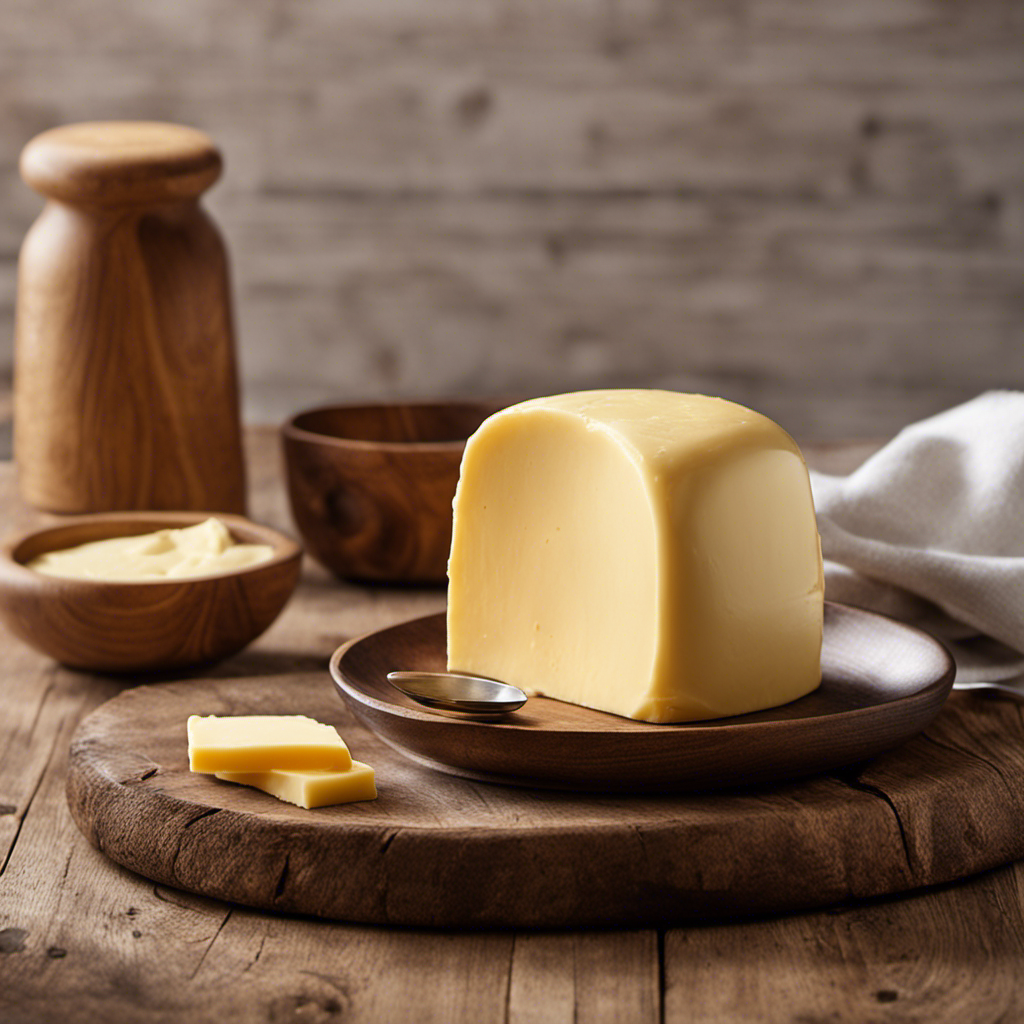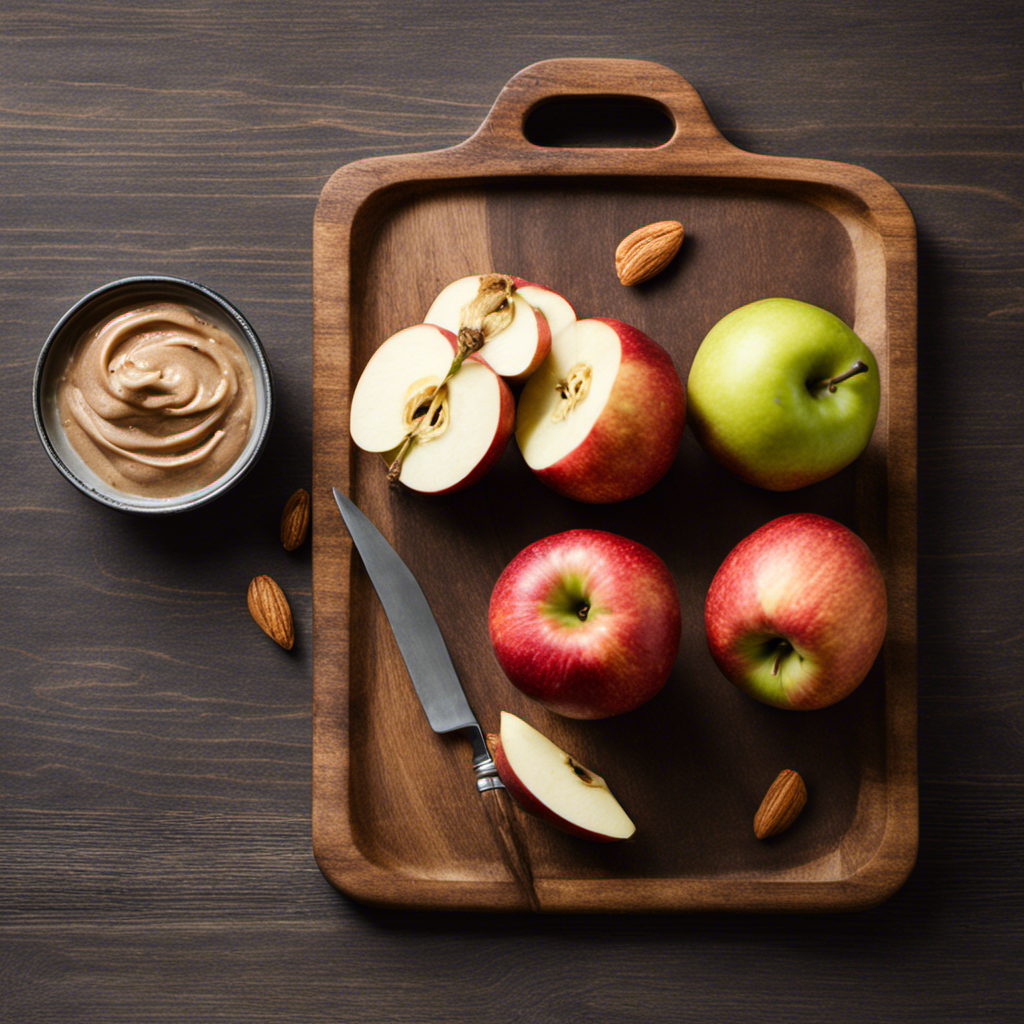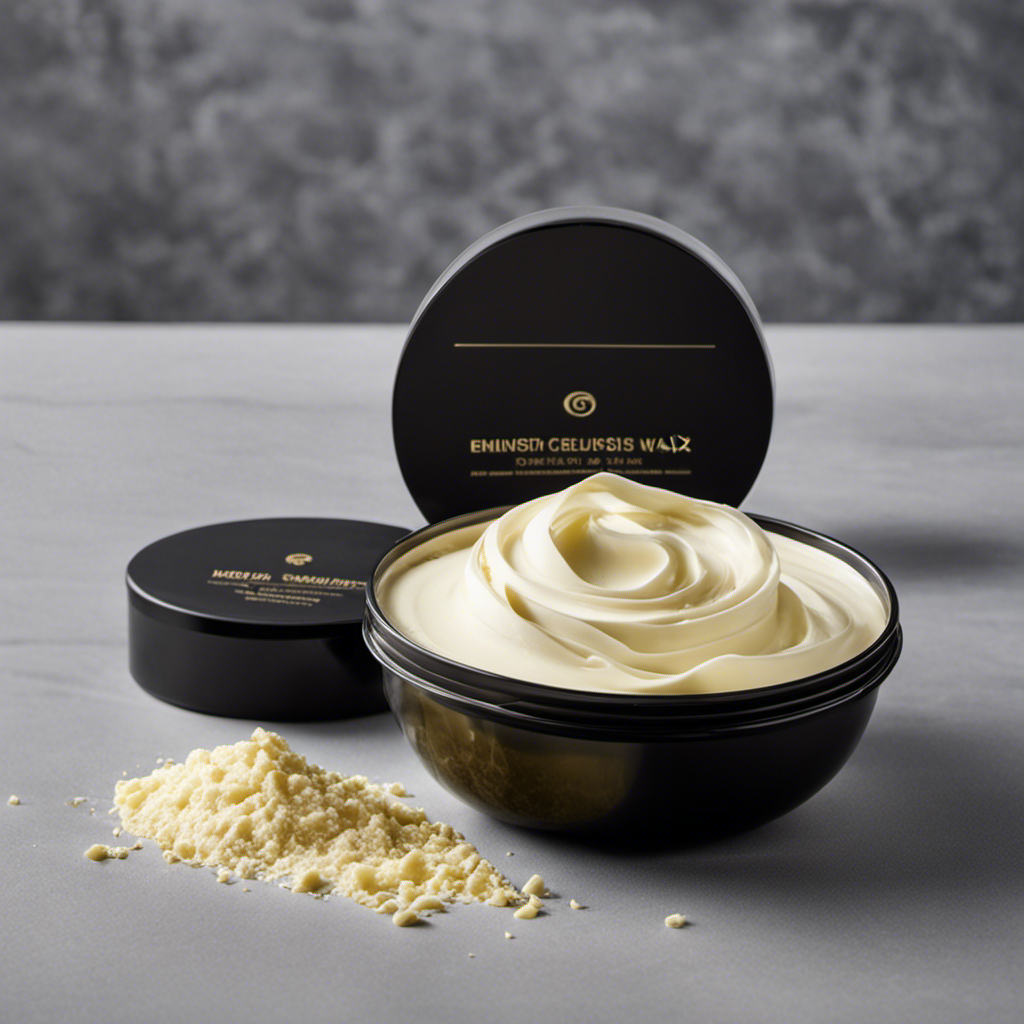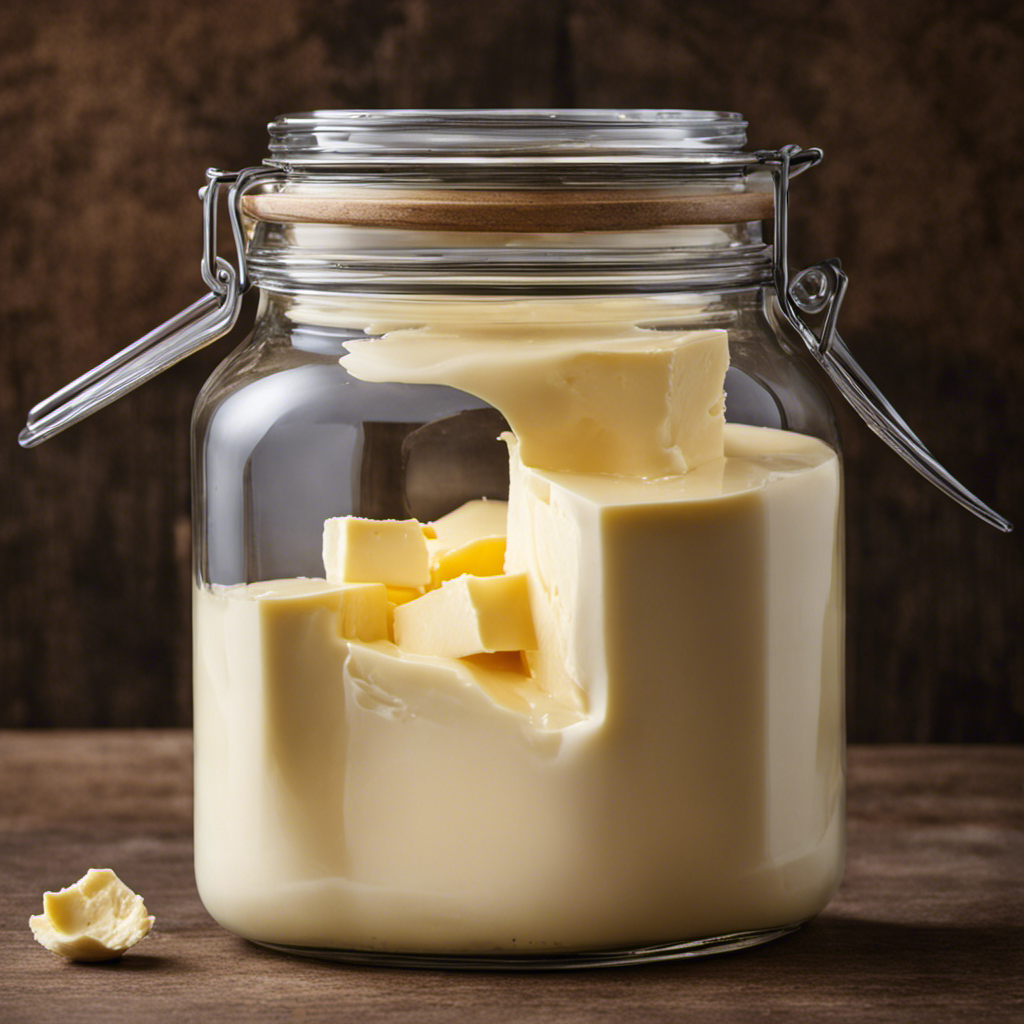Have you ever wondered what exactly is meant by the phrase ‘knob of butter’?
Well, I’m here to shed some light on this culinary mystery. A knob of butter is a small, measured amount of butter that is often used in cooking and baking. It adds richness and flavor to a variety of dishes, from savory sauces to sweet pastries.
In this article, we’ll delve into the origin of the term, different names for a knob of butter, its culinary uses, and much more.
So, let’s dive in and discover the world of butter knobs together!
Key Takeaways
- The term ‘knob of butter’ refers to a specific measurement of butter used in cooking.
- Butter knobs bring enhanced flavor, creaminess, and richness to recipes.
- Butter knobs have a wide range of uses and are versatile in various cooking methods.
- Butter knobs are preferred by professional chefs and are considered a culinary essential.
The Origin of the Term
The origin of the term ‘knob of butter’ is uncertain. However, it is believed to have originated from regional butter terminology, particularly in the United Kingdom.
A knob of butter refers to a small, rounded portion of butter that is typically used for cooking or spreading on bread. While it may seem like a simple term, the cultural significance of butter knobs cannot be overlooked.
In many cultures, butter is considered a staple ingredient and holds a special place in culinary traditions. The term ‘knob of butter’ may vary in different regions, but it represents the importance of this creamy, rich ingredient in various cuisines.
Whether melted over vegetables or slathered onto warm toast, a knob of butter adds a delicious and comforting touch to any dish.
Different Names for a Knob of Butter
When it comes to butter, have you ever wondered about the portion sizes? It turns out that different regions have their own terms for a knob of butter, which adds an interesting twist to the conversation.
Additionally, there are variations in how butter is measured, which can further complicate things. Let’s dive into the fascinating world of butter portion sizes, regional butter terms, and butter measurement variations.
Butter Portion Sizes
Butter portion sizes can vary depending on the brand and the country. When it comes to measuring butter accurately, it’s important to know the standard portion sizes.
In the United States, butter is typically sold in sticks, with each stick measuring about 1/2 cup or 8 tablespoons. This makes it easy to measure out precise amounts for baking or cooking.
However, in European countries, butter is often sold in smaller blocks or tubs, making it a bit more challenging to measure accurately. In these cases, it’s helpful to have a kitchen scale on hand to weigh the butter in grams or ounces. This ensures that you’re using the correct amount and achieving the desired results in your recipes.
Regional Butter Terms
In different regions, people may use various terms to refer to butter. It’s fascinating how language and culture can influence the way we talk about food. For example, in England, a small amount of butter is often referred to as a "knob". It’s a charming term that adds a touch of whimsy to the dining experience. To give you a better idea of how butter portion sizes vary across cultures, take a look at this table:
| Region | Butter Portion Size |
|---|---|
| England | Knob |
| France | Noisette |
| Germany | Klecks |
As you can see, each country has its own unique term for a small amount of butter. It’s these little linguistic quirks that make exploring different cultures so interesting. So next time you’re enjoying a meal, take a moment to appreciate the regional butter terminology and the rich diversity it represents.
Butter Measurement Variations
It’s fascinating to see how different cultures measure small amounts of butter in unique ways.
In some countries, like the United States, butter is typically measured using tablespoons or cups. However, in other parts of the world, such as Europe, butter is often measured using a unit known as a ‘knob.’
A knob of butter is not an exact measurement, but rather a rough estimate. It refers to a small, rounded portion of butter, roughly the size of a walnut or a small knob on a door.
While there is no precise conversion for butter knob equivalents, it is generally understood that one knob of butter is approximately equal to one tablespoon or 14 grams.
Size and Measurement of a Knob of Butter
When it comes to butter, it’s essential to know the standard portion size. But what exactly is a knob of butter?
This discussion will delve into the varying sizes of butter knobs and how to accurately measure them. Whether you’re spreading it on toast or using it for baking, understanding the size and measurement of a knob of butter can make all the difference in your cooking endeavors.
Standard Butter Portion
You can easily determine the standard butter portion by using a knob of butter. A knob of butter is a small, rounded portion that fits comfortably in the palm of your hand. It is typically about the size of a walnut or a tablespoon. This standard butter portion is commonly used in culinary preparations and recipes.
Here are four culinary uses for a knob of butter:
-
Sauteing: A knob of butter adds richness and flavor when used to saute vegetables, meats, or seafood.
-
Baking: Incorporate a knob of butter into your favorite cake or cookie recipe for a moist and tender texture.
-
Toast: Spread a knob of butter onto warm toast for a simple and satisfying breakfast or snack.
-
Finishing touch: Add a knob of butter to finish off sauces, soups, or pasta dishes for a silky smooth texture and enhanced flavor.
Using a knob of butter in these culinary applications ensures that you are using the appropriate amount for the desired result. So go ahead, grab a knob of butter, and let your creativity in the kitchen shine!
Varying Knob Sizes
To determine the appropriate amount of butter to use, consider the varying sizes of the rounded portions commonly used in culinary preparations. Butter knob sizes can vary depending on the region and culinary traditions.
In some countries, a knob of butter is typically around 1 tablespoon (14 grams) in size, while in others it can be as large as 2 tablespoons (28 grams). These common butter knob measurements are often used as a reference point in recipes, giving us a general idea of how much butter to add.
However, it’s important to note that personal preference and the specific dish being prepared may also play a role in determining the amount of butter needed. So, next time you’re cooking, keep in mind the different butter knob sizes and adjust accordingly for a delicious result!
Measuring Butter Accurately
Remember that accurately measuring butter is crucial for achieving the desired results in your culinary creations. Here are four tips to help you measure butter accurately:
-
Use a kitchen scale: Weighing butter on a scale ensures precise measurements, especially when recipes call for specific amounts in grams or ounces.
-
Use measuring spoons: If you don’t have a scale, measuring spoons can be a reliable alternative. One tablespoon is equivalent to one standard knob of butter.
-
Follow the markings on the packaging: Many butter packages come with measurements marked on the wrapping. Simply cut along the indicated lines to get the desired amount.
-
Use a butter dish with markings: Some butter dishes have markings indicating tablespoon measurements. This makes it easy to slice off the required amount.
Now that you know how to measure butter accurately, let’s explore the culinary uses for a knob of butter.
Culinary Uses for a Knob of Butter
There’s no denying the richness that a knob of butter adds to a sautéed vegetable dish. The butter melts, coating each piece with a luxurious flavor and creating a beautiful sheen.
But its uses go far beyond just sautéing. A knob of butter is a versatile ingredient that can enhance a wide range of dishes. One of the benefits of using a knob of butter in cooking is its ability to add richness and depth of flavor. Whether you’re making a creamy sauce, a velvety mashed potato, or a flaky pastry, butter can take your dish to the next level.
Its creamy texture and subtle saltiness make it a perfect addition to both sweet and savory recipes. With its incredible flavor and versatility, butter knobs are a staple ingredient in traditional recipes as well.
Butter Knobs in Traditional Recipes
When it comes to cooking, butter knobs are a crucial ingredient that can make all the difference in a recipe. In this discussion, I’ll be sharing some helpful tips on converting butter knobs to measurements, ensuring that your recipes turn out perfectly every time.
Additionally, we’ll explore the importance of butter knobs in traditional recipes and how they contribute to the overall flavor and texture of the dish.
Butter Knob Conversion Tips
To easily convert butter knob measurements, simply divide the amount in tablespoons by 8.
Here are four tips to help you with butter knob conversions:
-
Baking Bliss: Butter knobs can add a burst of flavor to your baked goods. Whether it’s cookies, cakes, or pastries, a knob of butter can elevate the taste and texture of your creations.
-
Saute Sensation: Use butter knobs to add richness and depth to your sauteed dishes. From vegetables to meats, a knob of butter can turn a simple dish into a culinary masterpiece.
-
Flaky Delights: Butter knobs are perfect for making flaky pie crusts and savory pastries. They create layers of buttery goodness that melt in your mouth with every bite.
-
Creamy Indulgence: Want to make your soups and sauces velvety smooth? Just add a knob of butter for a creamy and luxurious finish.
With these conversion tips and creative uses, butter knobs can become your secret ingredient for delicious and decadent dishes.
Importance of Butter Knobs
When it comes to cooking, using butter knobs is an essential technique that can elevate your dishes to a whole new level. The importance of using butter knobs lies in the rich flavor and creamy texture they bring to recipes. Not only do these small portions of butter add depth and richness to sauces, but they also provide a smooth and velvety finish to baked goods.
Let me show you the benefits of using butter knobs in a table:
| Benefits of Using Butter Knobs |
|---|
| Enhances Flavor |
| Adds Creaminess |
| Improves Texture |
| Provides Richness |
| Imparts a Velvety Finish |
As you can see, butter knobs are not just a simple ingredient, but rather a secret weapon in the kitchen. So next time you’re cooking, don’t forget to reach for those butter knobs and unlock the true potential of your recipes!
Butter Knobs in Gourmet Cooking
Butter knobs are a versatile ingredient in gourmet cooking. They come in different sizes and can be used in a variety of ways in modern cooking. Here are four reasons why butter knobs are a must-have in your kitchen:
-
Enhance flavor: Adding a knob of butter to a dish can instantly elevate its taste. The rich and creamy flavor of butter adds depth and richness to sauces, soups, and even roasted vegetables.
-
Improve texture: Butter knobs are commonly used to create smooth and creamy sauces or to add a velvety finish to mashed potatoes and risottos. The fat content in butter helps to create a luscious and silky texture.
-
Ideal for baking: Butter knobs are essential in baking as they provide moisture and richness to cakes, cookies, and pastries. They help to achieve a tender crumb and a deliciously buttery flavor.
-
Versatile ingredient: From sautéing vegetables to basting meats, butter knobs can be used in various cooking techniques. They can also be melted and brushed onto bread for a golden and crispy crust.
Knob of Butter Alternatives
Using substitutes, such as margarine or coconut oil, can be a suitable alternative to achieve similar richness and flavor in cooking. These knob of butter substitutes can be used in a variety of creative ways to enhance the taste of a dish. For example, margarine can be used to make a creamy butter sauce for pasta or vegetables, while coconut oil can add a subtle tropical flavor to baked goods. Here is a table showcasing the different knob of butter substitutes and their uses:
| Substitute | Uses |
|---|---|
| Margarine | Butter sauce, sautéing, baking |
| Coconut oil | Baking, stir-frying, flavoring |
| Olive oil | Salad dressings, roasting, grilling |
Butter Knobs in Baking
To enhance your baking, you can try using knob substitutes like margarine or coconut oil for added richness and flavor. However, there’s something special about using butter knobs in pastry making that just can’t be replicated.
Here are four creative uses for butter knobs that will take your baking to the next level:
-
Flaky Pie Crust: Incorporating cold butter knobs into your pie crust dough creates those perfect layers of flakiness that everyone loves.
-
Buttery Croissants: The secret to achieving that buttery and indulgent flavor of croissants lies in using butter knobs to create the laminated layers of dough.
-
Tender Cookies: Adding small chunks of butter knobs to your cookie dough gives them a melt-in-your-mouth texture and a rich buttery taste.
-
Delicious Scones: Using butter knobs in scone dough results in a tender and crumbly texture, making each bite a delightful experience.
How to Store a Knob of Butter
Storing a knob of butter properly will help to maintain its freshness and prevent it from spoiling too quickly. One way to store butter is to keep it in the refrigerator. However, if you want to soften the butter quickly for spreading, there are a few tricks you can try.
One method is to place the knob of butter on a plate and microwave it for about 10 seconds. Another option is to grate the butter while it’s still cold, which will make it easier to spread.
Aside from its traditional uses in cooking and baking, there are also creative ways to use butter knobs. For example, you can use a knob of butter to grease a pan before cooking pancakes or scrambled eggs. Butter can also be melted and drizzled over popcorn for a delicious and indulgent treat. Additionally, you can spread softened butter on warm bread and sprinkle it with cinnamon and sugar for a tasty homemade cinnamon toast.
Butter Knobs in Different Cuisines
Butter knobs are commonly used in various cuisines around the world, adding richness and flavor to dishes. Here are four fascinating regional butter dishes that showcase the cultural significance of butter knobs:
-
Beurre Manié (France): This is a classic French technique where equal parts butter and flour are kneaded together to create a smooth paste. It is used as a thickening agent for sauces and soups.
-
Ghee (India): Ghee is a clarified butter commonly used in Indian cuisine. It is made by simmering butter until the milk solids separate, resulting in a rich and nutty flavor. Ghee is highly valued for its aromatic qualities and is often used in cooking and as a condiment.
-
Smørrebrød (Denmark): Smørrebrød is a traditional Danish open-faced sandwich. Butter is spread generously on a slice of rye bread as a base for various toppings such as pickled herring, smoked salmon, or cheese.
-
Lurpak (Denmark): Lurpak is a well-known Danish brand of butter known for its distinct flavor and creamy texture. It is widely used in cooking and baking around the world.
These regional butter dishes not only enhance the taste of the cuisine but also reflect the cultural heritage and traditions of their respective regions.
Fun Facts About Butter Knobs
Did you know that butter knobs can be used in a variety of creative ways? You can shape them into fun molds or use them as decorative accents on dishes. These little knobs of butter are not only delicious but also versatile when it comes to culinary uses.
One fun fact about butter knobs is that they can be infused with different flavors. You can add herbs, spices, or even citrus zest to give your dishes an extra kick. Imagine the possibilities!
Another interesting fact is that butter knobs can be frozen and stored for a long time. This makes them convenient for future use. You can always have some on hand whenever you need them.
Frequently Asked Questions
What Is the Nutritional Value of a Knob of Butter?
A knob of butter is a small amount of butter typically used for cooking or spreading on bread. While it adds richness and flavor to dishes, it’s important to note that it is high in saturated fats and calories. As for alternative uses, some people use it for moisturizing dry skin or removing sticky residue.
Can a Knob of Butter Be Used as a Substitute for Other Fats in Cooking?
Sure, a knob of butter can be used as a substitute for other fats in cooking. It adds richness and flavor to dishes. But did you know that a single knob of butter contains about 35 calories?
Are There Any Health Benefits or Drawbacks of Consuming Butter Knobs?
There are both health benefits and drawbacks to consuming butter knobs. Butter is a good source of fat-soluble vitamins and can add flavor to dishes. However, it is high in saturated fat and should be consumed in moderation.
How Long Does a Knob of Butter Typically Last Before Spoiling?
A knob of butter, like a fleeting ray of sunshine, can brighten any dish. When stored properly, its shelf life can span several weeks. To keep it fresh, store in an airtight container in the fridge.
Are There Any Cultural or Historical Significance Associated With Butter Knobs?
Cultural traditions and butter carving have a long and rich history. Butter knobs hold significance in various cultures, often used as decorative elements or symbols of abundance and prosperity. They add beauty and flavor to dishes.
Conclusion
In conclusion, a knob of butter is a delightful dairy delight that adds depth and richness to dishes. Its origins may be mysterious, but its uses are vast and varied.
Whether you’re sautéing, baking, or spreading on toast, a knob of butter brings a burst of flavor that can’t be beat. So store it properly, experiment with it in different cuisines, and embrace the buttery bliss that a knob of butter brings.
Butter knobs, the tiny taste explosions that tantalize and titillate your taste buds!










